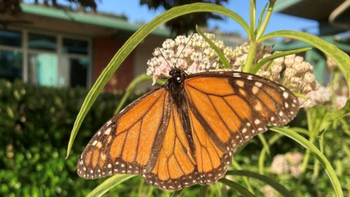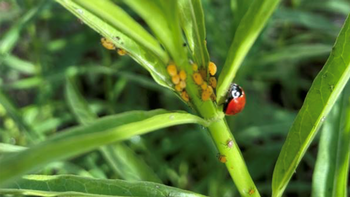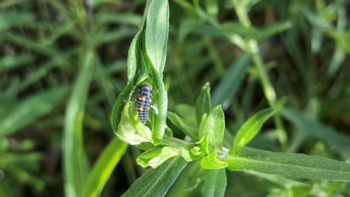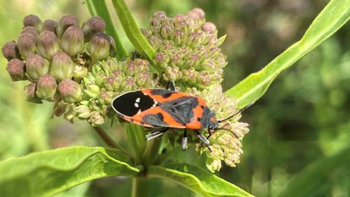Balancing the bugs on your native milkweed
-
Alice Cason
-
Bugs are everywhere pollinating our favorite flowers, fruits and vegetables and serving lunch for the birds. They provide an important service for the food supply for people, animals, insects and butterflies. How do we know which insect to control and which to report to the UC Cooperative Extension office? First investigate the nature around us. Insects are pollinators and predators. They can also be parasitoids--small insects whose immature stages develop either within or attached to the outside of other insects who are then their hosts. Insects can also be the decomposers in our compost pile. UC Marin Master Gardeners are taught the principles of Integrated Pest Management (IPM). We identify the pest problem and solve it using the least toxic solution that does the least amount of harm to the environment.
 Plant milkweed and Monarchs will come. This female Monarch feeds on nectar from the flowers. She lays eggs on the host plant. Photo: Alice CasonI identified some orange aphids, known as oleander aphids, on my narrow leaf milkweeds (Asclepias fascicularis). This is a plant native to Marin, the western U.S. coast and Mexico and a critical host to Monarch butterflies. It has a milky latex sap containing cardenolides, a chemical that when ingested makes the monarch caterpillars toxic and resistant to predators. Monarchs only lay eggs on milkweeds and the caterpillars only eat milkweed. Get used to seeing the leaves chewed by the hungry caterpillars. That’s right, there will be holes in the leaves. This is a sign of success that your host plants are doing their job.
Plant milkweed and Monarchs will come. This female Monarch feeds on nectar from the flowers. She lays eggs on the host plant. Photo: Alice CasonI identified some orange aphids, known as oleander aphids, on my narrow leaf milkweeds (Asclepias fascicularis). This is a plant native to Marin, the western U.S. coast and Mexico and a critical host to Monarch butterflies. It has a milky latex sap containing cardenolides, a chemical that when ingested makes the monarch caterpillars toxic and resistant to predators. Monarchs only lay eggs on milkweeds and the caterpillars only eat milkweed. Get used to seeing the leaves chewed by the hungry caterpillars. That’s right, there will be holes in the leaves. This is a sign of success that your host plants are doing their job. A lady beetle ready for an aphid lunch. Aphids secrete honeydew which attract ants, and ants protect the aphids from predators. Photo: Alice Cason
A lady beetle ready for an aphid lunch. Aphids secrete honeydew which attract ants, and ants protect the aphids from predators. Photo: Alice CasonFortunately, the oleander aphid only feeds on milkweed and oleander (nothing else), and even then, it rarely kills a mature plant. It does produce a sap called honeydew which attracts ants and some beneficial insects. Aphid predators include the lady bug, lady bug larva, the syrphid or hoverfly and the green lacewing beetle and its larva and more.
Watch and observe nature and choose the best solution. Rather than spraying pesticides you can wash the aphids off with water in the early morning. Be careful when spraying the underside of the milkweed leaves where you might interfere with a monarch egg. You can also squish them with your fingers. (Wear gloves if you don’t like the orange sap on your hands.) The most fun is to watch lady bugs come solve the problem by consuming the aphids. This is biological control. You may notice lady beetle larvae that look like little black and orange alligators, but are also beneficial insects that eat their share of aphids. The lady bug larva looks like a orange and black alligator, but can consume many aphids while making a complete metamorphosis. Photo: Alice Cason
The lady bug larva looks like a orange and black alligator, but can consume many aphids while making a complete metamorphosis. Photo: Alice CasonMany things prey on aphids. This “community “of insects are linked together with a common breakfast – the milkweed plant. According to Anurag Agrawal, author of “Monarchs and Milkweed” there are a total of 11 species of insects that frequently attack common milkweed. They create a balance of predator or prey that have evolved over millions of years.
When the milkweed starts to make seed pods for and a new insect appears- the Western small milkweed bug, Lygaeus kalmii. This seed-eating bug is red and black and sequesters cardenolides, the same sap that makes the Monarch resistant to predators. By including these and other native plants in your landscape you provide food sources for insects and healthy bug habitat. This seed-eating Western Smalll Milkweed Bug has the same orange and black colors as the Monarch butterfly to ward off predators. Photo: Alice Cason
This seed-eating Western Smalll Milkweed Bug has the same orange and black colors as the Monarch butterfly to ward off predators. Photo: Alice CasonPlant milkweeds in full sun and well-drained soil. Asclepias fascicularis is a perennial with light green narrow leaves on 3 ft. stalks. Pink and white clusters of flowers bloom in the summer. Milkweed is also poisonous if ingested. Mulch heavily and water well until established. Please do not plant milkweeds within 5 miles of the Pacific Coast and the overwintering sites as it can interfere with the Monarch migration.
Native narrow leaf milkweed plants go dormant in the winter and return faithfully the following spring at the right time for the Monarchs to come. Enjoy the community of insects that come with them, the host plants for beautiful butterflies in your garden.




